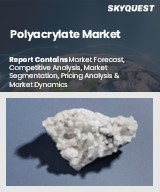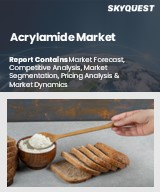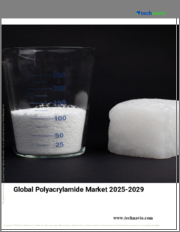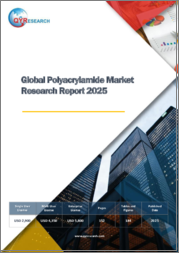
|
시장보고서
상품코드
1611972
세계의 아크릴아미드 시장 : 형태별, 등급별, 용도별 - 예측(2025-2030년)Acrylamide Market by Form (Aqueous Solution, Solid), Grade (Electrophoresis & Ultra Pure Grade Acrylamide, Technical Grade Acrylamide), Application - Global Forecast 2025-2030 |
||||||
아크릴아미드 시장은 2023년에 50억 9,000만 달러로 평가되었고, 2024년에는 53억 7,000만 달러로 추정되며, CAGR 5.69%로 성장할 전망이고, 2030년에는 75억 달러에 도달할 것으로 예측되고 있습니다.
아크릴아미드는 특히 수처리, 제지, 합성 섬유 및 플라스틱의 생산과 같은 다양한 산업에서 중요한 관련성을 가진 화합물입니다. 일부 식품에서는 고온 조리 과정에서 생성되어 폐수 처리용 폴리아크릴아미드 제조 및 화장품 제제에도 응용되고 있습니다. 아크릴아미드의 필요성은 최종 제품에 요구되는 구조적 및 화학적 특성을 향상시키는 중합체를 형성하는데 효과적이기 때문입니다. 그러나, 아크릴아미드의 잠재적인 발암성, 특히 식품 소비에 관한 건강에 대한 우려가 높아져, 규제 당국에 의한 감시가 강화되고 있습니다. 이 모니터링은 식품 용도에 영향을 미치는 한편, 인체에 직접 노출이 적은 산업 용도 분야 수요도 견인하고 있습니다. 아크릴아미드 시장에 영향을 미치는 주요 성장 요인으로는 석유 증진 회수 공정의 유용성 확대와 효율적이고 환경 친화적인 수처리 솔루션에 대한 수요 증가가 있습니다. 게다가 지속가능한 관행으로의 산업 이동은 보다 안전한 아크릴아미드 대체품의 조사 기회를 제공합니다. 개발 기업은 보다 환경 친화적이고 유해성이 낮은 아크릴아미드 유도체를 개발하는 기술 혁신에 투자함으로써 이 수요를 활용하여 규제와 환경기준에 적합해야 합니다. 그러나 엄격한 정부 규제, 특히 FDA 및 EFSA와 같은 소모품에 포함된 아크릴아미드 농도를 감독하는 기관의 규제라는 과제도 남아 있습니다. 기업은 식품 중 아크릴아미드 형성을 줄이는 기술을 모색하고 비독성 변이체를 개발하기 위한 합성 생물학에 투자함으로써 이러한 제약을 극복해야 합니다. 생산 비용 절감과 아크릴아미드 용도의 효율 향상을 목표로 한 혁신은 특히 석유 회수 및 수처리 등의 분야에서 시장의 추가 확대를 촉진할 가능성이 있습니다. 또한 바이오 폴리머 기술의 활용은 아크릴아마이드 시장 변혁의 매력적인 가능성을 제시하며 신중한 시장 환경 속에서 환경적 이익과 비즈니스 성장 기회를 모두 제공합니다. 개발 주체에게는, 진화하는 규제나 소비자 안전에 대한 관심에 따른 적극적인 제품 개발 전략으로, 기민하게 대응하는 것이 장려됩니다.
| 주요 시장 통계 | |
|---|---|
| 기준년(2023년) | 50억 9,000만 달러 |
| 예측년(2024년) | 53억 7,000만 달러 |
| 예측년(2030년) | 75억 달러 |
| CAGR(%) | 5.69% |
시장 역학 : 빠르게 진화하는 아크릴아미드 시장의 주요 시장 인사이트 공개
아크릴아미드 시장은 수요 및 공급의 역동적인 상호 작용에 의해 변모를 이루고 있습니다. 이러한 시장 역학의 진화를 이해함으로써 기업은 충분한 정보를 바탕으로 투자결정, 전략적 결정 정밀화, 새로운 비즈니스 기회 획득에 대비할 수 있습니다. 이러한 동향을 종합적으로 파악함으로써 기업은 정치적, 지리적, 기술적, 사회적, 경제적 영역에 걸친 다양한 리스크를 경감할 수 있을 뿐만 아니라, 소비자 행동과 그것이 제조 비용 또는 구매 동향에 미치는 영향을 보다 명확하게 이해할 수 있습니다.
- 시장 성장 촉진요인
- 석유화학산업 확대 및 석유증진회수 프로세스 수요
- 생물의학 연구 용도에서 고순도 아크릴아미드 수요 증가
- 제지 공장에서 아크릴아미드의 중요한 용도
- 시장 성장 억제요인
- 원료의 가격과 입수 가능성의 변동
- 시장 기회
- 폐수 처리 플랜트의 중요성과 투자 증가
- 바이오 아크릴아미드의 출현과 개발
- 시장의 과제
- 아크릴아미드에의 노출에 수반하는 독성 문제
Porter's Five Forces : 아크릴아미드 시장을 탐색하는 전략 도구
Porter's Five Forces 프레임워크는 아크릴아미드 시장 경쟁 구도를 이해하는 중요한 도구입니다. Porter's Five Forces 프레임워크는 기업의 경쟁력을 평가하고 전략적 기회를 찾기 위한 명확한 기법을 제공합니다. 이 프레임워크는 기업이 시장 내 판도를 평가하고 신규 사업의 수익성을 판단하는 데 도움이 됩니다. 이러한 인사이트를 통해 기업은 자사의 강점을 활용하고, 약점에 대처하며, 잠재적인 과제를 회피할 수 있으며, 보다 강인한 시장에서의 포지셔닝을 확보할 수 있습니다.
PESTLE 분석 : 아크릴아미드 시장에서 외부로부터의 영향 파악
외부 거시 환경 요인은 아크릴아미드 시장의 성과 역학을 형성하는 데 매우 중요한 역할을 합니다. 정치적, 경제적, 사회적, 기술적, 법적, 환경적 요인 분석은 이러한 영향을 탐색하는 데 필요한 정보를 제공합니다. PESTLE 요인을 조사함으로써 기업은 잠재적인 위험과 기회를 더 잘 이해할 수 있습니다. 이 분석을 통해 기업은 규제, 소비자 선호, 경제 동향의 변화를 예측하고 앞으로 예상되는 적극적인 의사 결정을 할 준비를 할 수 있습니다.
시장 점유율 분석 : 아크릴아미드 시장 경쟁 구도 파악
아크릴아미드 시장의 상세한 시장 점유율 분석을 통해 공급업체의 성과를 종합적으로 평가할 수 있습니다. 기업은 수익, 고객 기반, 성장률 등 주요 지표를 비교하여 경쟁 포지셔닝을 밝힐 수 있습니다. 이 분석을 통해 시장 집중, 단편화, 통합 동향을 밝혀내고 벤더들은 경쟁이 치열해지는 가운데 자사의 지위를 높이는 전략적 의사 결정을 내리는 데 필요한 지식을 얻을 수 있습니다.
FPNV 포지셔닝 매트릭스 : 아크릴아미드 시장에서 공급업체의 성능 평가
FPNV 포지셔닝 매트릭스는 아크릴아미드 시장에서 공급업체를 평가하는 중요한 도구입니다. 이 매트릭스를 통해 비즈니스 조직은 공급업체의 비즈니스 전략과 제품 만족도를 기준으로 평가하여 목표에 맞는 충분한 정보를 바탕으로 의사 결정을 내릴 수 있습니다. 네 가지 사분면을 통해 공급업체를 명확하고 정확하게 세분화하여 전략 목표에 가장 적합한 파트너 및 솔루션을 파악할 수 있습니다.
전략 분석 및 추천 : 아크릴아미드 시장에서 성공을 위한 길을 그리기
아크릴아미드 시장의 전략 분석은 세계 시장에서의 존재를 강화하려는 기업에 필수적입니다. 주요 자원, 역량 및 성과 지표를 검토함으로써 기업은 성장 기회를 파악하고 개선을 위해 노력할 수 있습니다. 이러한 접근 방식을 통해 경쟁 구도에서 과제를 극복하고 새로운 비즈니스 기회를 활용하여 장기적인 성공을 거둘 수 있는 체제를 구축할 수 있습니다.
이 보고서는 주요 관심 분야를 포괄하는 시장의 종합적인 분석을 제공합니다.
1. 시장 침투 : 현재 시장 환경의 상세한 검토, 주요 기업의 광범위한 데이터, 시장 도달범위 및 전반적인 영향력을 평가합니다.
2. 시장 개척도 : 신흥 시장의 성장 기회를 파악하고 기존 분야의 확장 가능성을 평가하며 미래 성장을 위한 전략적 로드맵을 제공합니다.
3. 시장 다양화 : 최근 제품 출시, 미개척 지역, 업계의 주요 진보, 시장을 형성하는 전략적 투자를 분석합니다.
4. 경쟁 평가 및 정보 : 경쟁 구도를 철저히 분석하여 시장 점유율, 사업 전략, 제품 포트폴리오, 인증, 규제 당국 승인, 특허 동향, 주요 기업의 기술 진보 등을 검증합니다.
5. 제품 개발 및 혁신 : 미래 시장 성장을 가속할 것으로 예상되는 최첨단 기술, 연구개발 활동, 제품 혁신을 강조합니다.
또한 이해관계자가 충분한 정보를 얻고 의사결정을 할 수 있도록 중요한 질문에 대답하고 있습니다.
1. 현재 시장 규모 및 향후 성장 예측은?
2. 최고의 투자 기회를 제공하는 제품, 부문 및 지역은 어디입니까?
3. 시장을 형성하는 주요 기술 동향 및 규제의 영향은?
4. 주요 벤더의 시장 점유율 및 경쟁 포지션은?
5. 벤더 시장 진입 및 철수 전략의 원동력이 되는 수익원과 전략적 기회는 무엇인가?
목차
제1장 서문
제2장 조사 방법
제3장 주요 요약
제4장 시장 개요
제5장 시장 인사이트
- 시장 역학
- 성장 촉진요인
- 석유화학산업 확대와 석유회수 강화 프로세스 수요
- 바이오메디컬 조사 용도에서 고순도 아크릴아미드 수요 증가
- 제지 공장에서 아크릴아미드의 중요한 용도
- 억제요인
- 원재료의 가격과 입수성의 변동
- 기회
- 폐수 처리 시설의 중요성과 투자의 증대
- 바이오 기반 아크릴아미드의 출현과 개발
- 과제
- 아크릴아미드에 대한 노출과 관련된 독성 문제
- 성장 촉진요인
- 시장 세분화 분석
- 형태별 : 크리스탈 아크릴아미드는 가장 순수한 형태로 의약품 및 고정밀 용도 분야 위한 실험실 조사에 적합
- 용도별 : 깨끗한 물공급을 확보하는 폐수 처리 프로세스의 보급
- Porter's Five Forces 분석
- PESTEL 분석
- 정치적
- 경제
- 사교
- 기술적
- 법률상
- 환경
제6장 아크릴아미드 시장 : 형태별
- 수용액
- 고체
- 연탄
- 크리스탈
제7장 아크릴아미드 시장 : 등급별
- 전기영동과 초고순도 등급 아크릴아미드
- 테크니컬 등급 아크릴아미드
제8장 아크릴아미드 시장 : 용도별
- 염색
- 분자 생물학
- 광석 처리
- 종이 및 펄프
- 물 및 폐수 처리
제9장 아메리카의 아크릴아미드 시장
- 아르헨티나
- 브라질
- 캐나다
- 멕시코
- 미국
제10장 아시아태평양의 아크릴아미드 시장
- 호주
- 중국
- 인도
- 인도네시아
- 일본
- 말레이시아
- 필리핀
- 싱가포르
- 한국
- 대만
- 태국
- 베트남
제11장 유럽, 중동 및 아프리카의 아크릴아미드 시장
- 덴마크
- 이집트
- 핀란드
- 프랑스
- 독일
- 이스라엘
- 이탈리아
- 네덜란드
- 나이지리아
- 노르웨이
- 폴란드
- 카타르
- 러시아
- 사우디아라비아
- 남아프리카
- 스페인
- 스웨덴
- 스위스
- 터키
- 아랍에미리트(UAE)
- 영국
제12장 경쟁 구도
- 시장 점유율 분석(2023년)
- FPNV 포지셔닝 매트릭스(2023년)
- 경쟁 시나리오 분석
- Kemira, 제지 업계용으로 바이오매스 밸런스의 습윤 강도 수지를 발매
- CD Bioparticles, 약물전달 용도용의 저PDI 폴리머의 신시리즈를 발매
- Mitsui Chemicals, 아크릴아미드 제조에 이용하는 생체 촉매의 생산 능력을 증강
- 전략 분석 및 제안
기업 목록
- Anhui Jucheng Fine Chemicals Co., Ltd.
- Ashland Inc.
- Ataman Acar Kimya AS
- BASF SE
- Beijing Hengju Chemical Group Co., Ltd
- Black Rose Industries Ltd.
- Central Drug House(P) Ltd.
- Emco Dyestuff Pvt. Ltd.
- Envitech Chemical Specialities Pvt. Ltd.
- Hefei TNJ Chemical Industry Co.,Ltd.
- Henan GO Biotech Co., Ltd.
- Ineos AG
- Innova Corporate
- Kemira Oyj
- Manus Aktteva Biopharma LLP
- Merck KGaA
- Mitsubishi Chemical Corporation
- Mitsui Chemicals, Inc.
- Novozymes A/S
- Otto Chemie Pvt. Ltd.
- Polysciences, Inc.
- Promega Corporation
- Shandong Nuoer Biological Technology Co., Ltd.
- Shanghai Guanru Chemical Co., Ltd.
- Solenis LLC
- The SNF Group
- Thermo Fisher Scientific Inc.
- Xitao Polymer Co., Ltd.
- Zhejiang Xinyong Biochemical Co., Ltd
- Zibo Xinye Chemical Co., Ltd.
The Acrylamide Market was valued at USD 5.09 billion in 2023, expected to reach USD 5.37 billion in 2024, and is projected to grow at a CAGR of 5.69%, to USD 7.50 billion by 2030.
Acrylamide is a chemical compound with substantial relevance across various industries, notably in water treatment, paper manufacturing, and the production of synthetic textiles and plastics. Formed in some foods during high-temperature cooking processes, it also has applications in polyacrylamide production for wastewater treatment and cosmetic formulations. The necessity of acrylamide arises from its effectiveness in forming polymers that improve desired structural and chemical properties in end products. However, growing health concerns regarding acrylamide's potential carcinogenicity, particularly related to food consumption, have led to increased regulatory scrutiny. This scrutiny affects its application in food products while still driving demand in industrial applications where less direct human exposure is involved. The primary growth factors influencing the acrylamide market include the expanding utility in enhanced oil recovery processes and the escalating demand for efficient and eco-friendly water treatment solutions. Furthermore, the industrial shift towards sustainable practices presents opportunities for research into safer acrylamide alternatives. Businesses should capitalize on this demand by investing in innovations that develop greener and less hazardous acrylamide derivatives, thereby aligning with regulatory and environmental standards. Nonetheless, challenges persist in the form of stringent government regulations, particularly from agencies like the FDA and EFSA that oversee acrylamide levels in consumable products. Companies must navigate these limitations by exploring technologies that reduce acrylamide formation in foods and invest in synthetic biology for developing non-toxic variants. Innovations aimed at reducing production costs and improving the efficiency of acrylamide applications, especially in sectors like oil recovery and water treatment, could catalyze further market expansion. Moreover, leveraging biopolymer technology presents intriguing potential for acrylamide market transformations, providing both environmental benefits and business growth opportunities in a cautious market landscape. Businesses are encouraged to stay agile, with proactive product development strategies that align with evolving regulations and consumer safety concerns.
| KEY MARKET STATISTICS | |
|---|---|
| Base Year [2023] | USD 5.09 billion |
| Estimated Year [2024] | USD 5.37 billion |
| Forecast Year [2030] | USD 7.50 billion |
| CAGR (%) | 5.69% |
Market Dynamics: Unveiling Key Market Insights in the Rapidly Evolving Acrylamide Market
The Acrylamide Market is undergoing transformative changes driven by a dynamic interplay of supply and demand factors. Understanding these evolving market dynamics prepares business organizations to make informed investment decisions, refine strategic decisions, and seize new opportunities. By gaining a comprehensive view of these trends, business organizations can mitigate various risks across political, geographic, technical, social, and economic domains while also gaining a clearer understanding of consumer behavior and its impact on manufacturing costs and purchasing trends.
- Market Drivers
- Expansion of petrochemical industries and demand for enhanced oil recoveries processes
- Growing demand for high purity acrylamide in biomedical research applications
- Significant applications of acrylamide in paper mills
- Market Restraints
- Fluctuating prices and availability of raw materials
- Market Opportunities
- Growing significance and investment for wastewater treatment plants
- Emergence and development of bio-based acrylamide
- Market Challenges
- Toxicity issues associated with exposure to acrylamide
Porter's Five Forces: A Strategic Tool for Navigating the Acrylamide Market
Porter's five forces framework is a critical tool for understanding the competitive landscape of the Acrylamide Market. It offers business organizations with a clear methodology for evaluating their competitive positioning and exploring strategic opportunities. This framework helps businesses assess the power dynamics within the market and determine the profitability of new ventures. With these insights, business organizations can leverage their strengths, address weaknesses, and avoid potential challenges, ensuring a more resilient market positioning.
PESTLE Analysis: Navigating External Influences in the Acrylamide Market
External macro-environmental factors play a pivotal role in shaping the performance dynamics of the Acrylamide Market. Political, Economic, Social, Technological, Legal, and Environmental factors analysis provides the necessary information to navigate these influences. By examining PESTLE factors, businesses can better understand potential risks and opportunities. This analysis enables business organizations to anticipate changes in regulations, consumer preferences, and economic trends, ensuring they are prepared to make proactive, forward-thinking decisions.
Market Share Analysis: Understanding the Competitive Landscape in the Acrylamide Market
A detailed market share analysis in the Acrylamide Market provides a comprehensive assessment of vendors' performance. Companies can identify their competitive positioning by comparing key metrics, including revenue, customer base, and growth rates. This analysis highlights market concentration, fragmentation, and trends in consolidation, offering vendors the insights required to make strategic decisions that enhance their position in an increasingly competitive landscape.
FPNV Positioning Matrix: Evaluating Vendors' Performance in the Acrylamide Market
The Forefront, Pathfinder, Niche, Vital (FPNV) Positioning Matrix is a critical tool for evaluating vendors within the Acrylamide Market. This matrix enables business organizations to make well-informed decisions that align with their goals by assessing vendors based on their business strategy and product satisfaction. The four quadrants provide a clear and precise segmentation of vendors, helping users identify the right partners and solutions that best fit their strategic objectives.
Strategy Analysis & Recommendation: Charting a Path to Success in the Acrylamide Market
A strategic analysis of the Acrylamide Market is essential for businesses looking to strengthen their global market presence. By reviewing key resources, capabilities, and performance indicators, business organizations can identify growth opportunities and work toward improvement. This approach helps businesses navigate challenges in the competitive landscape and ensures they are well-positioned to capitalize on newer opportunities and drive long-term success.
Key Company Profiles
The report delves into recent significant developments in the Acrylamide Market, highlighting leading vendors and their innovative profiles. These include Anhui Jucheng Fine Chemicals Co., Ltd., Ashland Inc., Ataman Acar Kimya A.S., BASF SE, Beijing Hengju Chemical Group Co., Ltd, Black Rose Industries Ltd., Central Drug House (P) Ltd., Emco Dyestuff Pvt. Ltd., Envitech Chemical Specialities Pvt. Ltd., Hefei TNJ Chemical Industry Co.,Ltd., Henan GO Biotech Co., Ltd., Ineos AG, Innova Corporate, Kemira Oyj, Manus Aktteva Biopharma LLP, Merck KGaA, Mitsubishi Chemical Corporation, Mitsui Chemicals, Inc., Novozymes A/S, Otto Chemie Pvt. Ltd., Polysciences, Inc., Promega Corporation, Shandong Nuoer Biological Technology Co., Ltd., Shanghai Guanru Chemical Co., Ltd., Solenis LLC, The SNF Group, Thermo Fisher Scientific Inc., Xitao Polymer Co., Ltd., Zhejiang Xinyong Biochemical Co., Ltd, and Zibo Xinye Chemical Co., Ltd..
Market Segmentation & Coverage
This research report categorizes the Acrylamide Market to forecast the revenues and analyze trends in each of the following sub-markets:
- Based on Form, market is studied across Aqueous Solution and Solid. The Solid is further studied across Briquettes and Crystals.
- Based on Grade, market is studied across Electrophoresis & Ultra Pure Grade Acrylamide and Technical Grade Acrylamide.
- Based on Application, market is studied across Dyeing, Molecular Biology, Ore Processing, Paper & Pulp, and Water & Wastewater Treatment.
- Based on Region, market is studied across Americas, Asia-Pacific, and Europe, Middle East & Africa. The Americas is further studied across Argentina, Brazil, Canada, Mexico, and United States. The United States is further studied across California, Florida, Illinois, New York, Ohio, Pennsylvania, and Texas. The Asia-Pacific is further studied across Australia, China, India, Indonesia, Japan, Malaysia, Philippines, Singapore, South Korea, Taiwan, Thailand, and Vietnam. The Europe, Middle East & Africa is further studied across Denmark, Egypt, Finland, France, Germany, Israel, Italy, Netherlands, Nigeria, Norway, Poland, Qatar, Russia, Saudi Arabia, South Africa, Spain, Sweden, Switzerland, Turkey, United Arab Emirates, and United Kingdom.
The report offers a comprehensive analysis of the market, covering key focus areas:
1. Market Penetration: A detailed review of the current market environment, including extensive data from top industry players, evaluating their market reach and overall influence.
2. Market Development: Identifies growth opportunities in emerging markets and assesses expansion potential in established sectors, providing a strategic roadmap for future growth.
3. Market Diversification: Analyzes recent product launches, untapped geographic regions, major industry advancements, and strategic investments reshaping the market.
4. Competitive Assessment & Intelligence: Provides a thorough analysis of the competitive landscape, examining market share, business strategies, product portfolios, certifications, regulatory approvals, patent trends, and technological advancements of key players.
5. Product Development & Innovation: Highlights cutting-edge technologies, R&D activities, and product innovations expected to drive future market growth.
The report also answers critical questions to aid stakeholders in making informed decisions:
1. What is the current market size, and what is the forecasted growth?
2. Which products, segments, and regions offer the best investment opportunities?
3. What are the key technology trends and regulatory influences shaping the market?
4. How do leading vendors rank in terms of market share and competitive positioning?
5. What revenue sources and strategic opportunities drive vendors' market entry or exit strategies?
Table of Contents
1. Preface
- 1.1. Objectives of the Study
- 1.2. Market Segmentation & Coverage
- 1.3. Years Considered for the Study
- 1.4. Currency & Pricing
- 1.5. Language
- 1.6. Stakeholders
2. Research Methodology
- 2.1. Define: Research Objective
- 2.2. Determine: Research Design
- 2.3. Prepare: Research Instrument
- 2.4. Collect: Data Source
- 2.5. Analyze: Data Interpretation
- 2.6. Formulate: Data Verification
- 2.7. Publish: Research Report
- 2.8. Repeat: Report Update
3. Executive Summary
4. Market Overview
5. Market Insights
- 5.1. Market Dynamics
- 5.1.1. Drivers
- 5.1.1.1. Expansion of petrochemical industries and demand for enhanced oil recoveries processes
- 5.1.1.2. Growing demand for high purity acrylamide in biomedical research applications
- 5.1.1.3. Significant applications of acrylamide in paper mills
- 5.1.2. Restraints
- 5.1.2.1. Fluctuating prices and availability of raw materials
- 5.1.3. Opportunities
- 5.1.3.1. Growing significance and investment for wastewater treatment plants
- 5.1.3.2. Emergence and development of bio-based acrylamide
- 5.1.4. Challenges
- 5.1.4.1. Toxicity issues associated with exposure to acrylamide
- 5.1.1. Drivers
- 5.2. Market Segmentation Analysis
- 5.2.1. Form: Suitability of crystalline acrylamide in pharmaceuticals and laboratory research for high precision applications owing to its purest form
- 5.2.2. Application: Proliferation in waste water treatment processes ensuring the supply of clean water
- 5.3. Porter's Five Forces Analysis
- 5.3.1. Threat of New Entrants
- 5.3.2. Threat of Substitutes
- 5.3.3. Bargaining Power of Customers
- 5.3.4. Bargaining Power of Suppliers
- 5.3.5. Industry Rivalry
- 5.4. PESTLE Analysis
- 5.4.1. Political
- 5.4.2. Economic
- 5.4.3. Social
- 5.4.4. Technological
- 5.4.5. Legal
- 5.4.6. Environmental
6. Acrylamide Market, by Form
- 6.1. Introduction
- 6.2. Aqueous Solution
- 6.3. Solid
- 6.3.1. Briquettes
- 6.3.2. Crystals
7. Acrylamide Market, by Grade
- 7.1. Introduction
- 7.2. Electrophoresis & Ultra Pure Grade Acrylamide
- 7.3. Technical Grade Acrylamide
8. Acrylamide Market, by Application
- 8.1. Introduction
- 8.2. Dyeing
- 8.3. Molecular Biology
- 8.4. Ore Processing
- 8.5. Paper & Pulp
- 8.6. Water & Wastewater Treatment
9. Americas Acrylamide Market
- 9.1. Introduction
- 9.2. Argentina
- 9.3. Brazil
- 9.4. Canada
- 9.5. Mexico
- 9.6. United States
10. Asia-Pacific Acrylamide Market
- 10.1. Introduction
- 10.2. Australia
- 10.3. China
- 10.4. India
- 10.5. Indonesia
- 10.6. Japan
- 10.7. Malaysia
- 10.8. Philippines
- 10.9. Singapore
- 10.10. South Korea
- 10.11. Taiwan
- 10.12. Thailand
- 10.13. Vietnam
11. Europe, Middle East & Africa Acrylamide Market
- 11.1. Introduction
- 11.2. Denmark
- 11.3. Egypt
- 11.4. Finland
- 11.5. France
- 11.6. Germany
- 11.7. Israel
- 11.8. Italy
- 11.9. Netherlands
- 11.10. Nigeria
- 11.11. Norway
- 11.12. Poland
- 11.13. Qatar
- 11.14. Russia
- 11.15. Saudi Arabia
- 11.16. South Africa
- 11.17. Spain
- 11.18. Sweden
- 11.19. Switzerland
- 11.20. Turkey
- 11.21. United Arab Emirates
- 11.22. United Kingdom
12. Competitive Landscape
- 12.1. Market Share Analysis, 2023
- 12.2. FPNV Positioning Matrix, 2023
- 12.3. Competitive Scenario Analysis
- 12.3.1. Kemira launches biomass balanced wet strength resins for the paper industry
- 12.3.2. CD Bioparticles Launches New Range of Low PDI Polymers for Drug Delivery Applications
- 12.3.3. Mitsui Chemicals to Increase Production Capacity for Biocatalysts Used in Acrylamide Production
- 12.4. Strategy Analysis & Recommendation
Companies Mentioned
- 1. Anhui Jucheng Fine Chemicals Co., Ltd.
- 2. Ashland Inc.
- 3. Ataman Acar Kimya A.S.
- 4. BASF SE
- 5. Beijing Hengju Chemical Group Co., Ltd
- 6. Black Rose Industries Ltd.
- 7. Central Drug House (P) Ltd.
- 8. Emco Dyestuff Pvt. Ltd.
- 9. Envitech Chemical Specialities Pvt. Ltd.
- 10. Hefei TNJ Chemical Industry Co.,Ltd.
- 11. Henan GO Biotech Co., Ltd.
- 12. Ineos AG
- 13. Innova Corporate
- 14. Kemira Oyj
- 15. Manus Aktteva Biopharma LLP
- 16. Merck KGaA
- 17. Mitsubishi Chemical Corporation
- 18. Mitsui Chemicals, Inc.
- 19. Novozymes A/S
- 20. Otto Chemie Pvt. Ltd.
- 21. Polysciences, Inc.
- 22. Promega Corporation
- 23. Shandong Nuoer Biological Technology Co., Ltd.
- 24. Shanghai Guanru Chemical Co., Ltd.
- 25. Solenis LLC
- 26. The SNF Group
- 27. Thermo Fisher Scientific Inc.
- 28. Xitao Polymer Co., Ltd.
- 29. Zhejiang Xinyong Biochemical Co., Ltd
- 30. Zibo Xinye Chemical Co., Ltd.



















